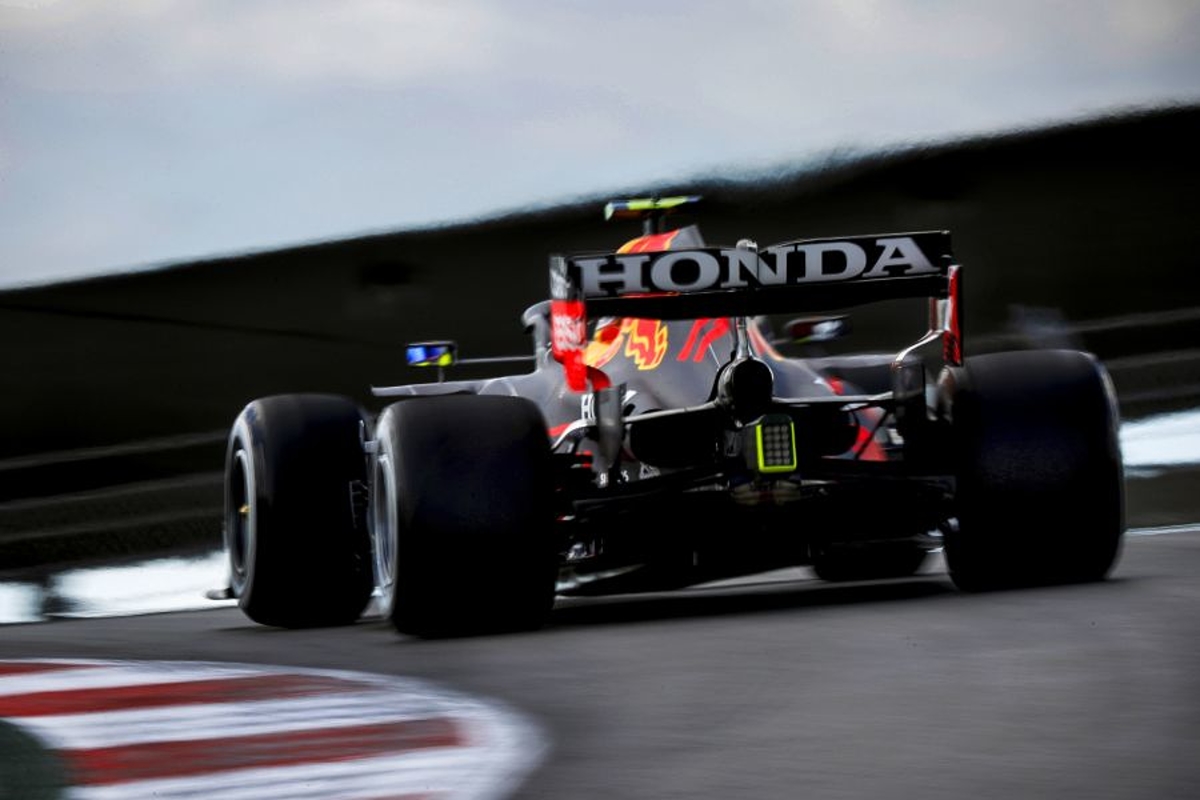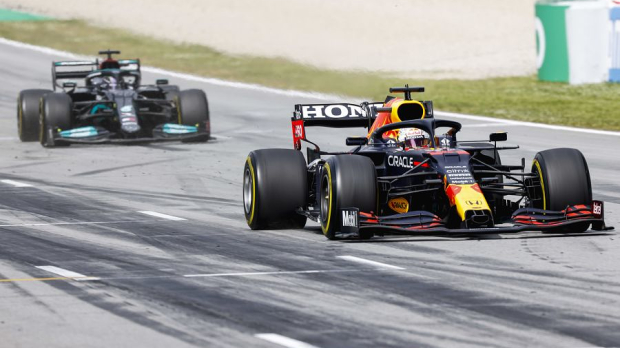
Why Red Bull flexi-wings are so effective
Why Red Bull flexi-wings are so effective

Would it be a true F1 title battle between two teams without a technical controversy along the way?
Mercedes has kicked up a storm over the so-called flexi, or limbo, rear wings after onboard footage at the Spanish Grand Prix showed the component on Red Bull's RB16B bending backwards down the pit straight.
The FIA has brought about changes to its load testing on the wings to ensure all components comply with the technical regulations but that in itself has caused a storm on both sides.
So let's take a look at what flexi-wings are, why there is such a fuss and who is affected by the furore.
Why Mercedes is concerned

So the rear wing leans back a degree. Big deal, right? Actually yes. There is a reason why regulations stop aerodynamic components from endlessly flexing.
Let's break it down. With little air resistance through a corner with a low maximum velocity, or V-max, the wing structure stays mostly rigid and upright because the load exerted from the air resistance is relatively low.
Because the wing remains upright, the resistance pushes the wing and the rear of the car with downward pressure, or downforce, which equals grip and ultimately cornering speed.
Now in a straight line, this downforce effectively becomes aerodynamic drag which limits the V-max. This is why slipstreaming is effective because when a car is tucked in behind another, this air resistance isn't acting upon the second car to the extent of the leading vehicle.
When the secondary car pulls out to make the move, the air resistance that then hits the aerofoils attached to it acts like a parachute which is why the closing speed dissipates so there is a convergence of the relative V-max.
Where the flexi-wing is such an advantage is on this specific point. Red Bull uses the aeroelasticity of its rear wing to reduce the surface area of the face of the wing in a straight line, thus reducing drag and increasing potential V-max.
Taking advantage of the aeroelasticity, however, the wing returns to a rigid state at lower speed to create the downforce needed through the corners. This means that the team can run with a higher wing setting without being penalised in a straight line.
In effect, the flexi-wing is a rudimentary drag reduction system and we all know how powerful that can be.
Related
Change your timezone:
Latest News

Audi agree STAR driver contract as Mercedes driver tipped for new F1 seat THIS season - GPFans F1 Recap
- 1 hour ago

Ferrari show off new-look drivers following HUGE announcement
- 2 hours ago

McLaren leading fight for HUGE cash injection
- 3 hours ago

Newey set to announce STUNNING Red Bull departure
- Yesterday 17:57

Newey Red Bull exit wish CONFIRMED as F1 guru's reasons revealed
- Yesterday 20:57

F1 legend reveals 'FLOOD' of death threats after controversial decision
- Yesterday 19:57
Related news

Horner reveals 'unhuman' Verstappen secret

Red Bull already sending parts to F1 race MONTHS away

Schumacher reveals what F1 pundits are NOT allowed to say about Red Bull

F1 team 'set to announce MEGA signing' in major Red Bull challenge
F1 Standings

Drivers
- Oliver Bearman
- Charles Leclerc
- Carlos Sainz
- Lando Norris
- Oscar Piastri
- Pierre Gasly
- Esteban Ocon
- Sergio Pérez
- Max Verstappen
- Alexander Albon
- Logan Sargeant
- Lewis Hamilton
- George Russell
- Nico Hülkenberg
- Kevin Magnussen
- Fernando Alonso
- Lance Stroll
- Valtteri Bottas
- Zhou Guanyu
- Daniel Ricciardo
- Yuki Tsunoda
Races
-
 Gulf Air Grand Prix of Bahrain 2024
Gulf Air Grand Prix of Bahrain 2024
-
 Saudi Arabian Grand Prix 2024
Saudi Arabian Grand Prix 2024
-
 Grand Prix of Australia 2024
Grand Prix of Australia 2024
-
 MSC Cruises Grand Prix of Japan 2024
MSC Cruises Grand Prix of Japan 2024
-
 Grand Prix of China 2024
Grand Prix of China 2024
-
 Miami Grand Prix 2024
Miami Grand Prix 2024
-
 Gran Premio dell'Emilia Romagna 2024
Gran Premio dell'Emilia Romagna 2024
-
 Grand Prix of Monaco 2024
Grand Prix of Monaco 2024
-
 Grand Prix du Canada 2024
Grand Prix du Canada 2024
-
 Gran Premio de España 2024
Gran Premio de España 2024
-
 Grand Prix of Austria 2024
Grand Prix of Austria 2024
-
 Grand Prix of Great Britain 2024
Grand Prix of Great Britain 2024
-
 Grand Prix of Hungary 2024
Grand Prix of Hungary 2024
-
 Grand Prix of Belgium 2024
Grand Prix of Belgium 2024
-
 Heineken Dutch Grand Prix 2024
Heineken Dutch Grand Prix 2024
-
 Grand Prix of Italy 2024
Grand Prix of Italy 2024
-
 Grand Prix of Azerbaijan 2024
Grand Prix of Azerbaijan 2024
-
 Grand Prix of Singapore 2024
Grand Prix of Singapore 2024
-
 Grand Prix of the United States 2024
Grand Prix of the United States 2024
-
 Gran Premio de la Ciudad de Mexico 2024
Gran Premio de la Ciudad de Mexico 2024
-
 Grande Prêmio de São Paulo 2024
Grande Prêmio de São Paulo 2024
-
 Heineken Silver Las Vegas Grand Prix 2024
Heineken Silver Las Vegas Grand Prix 2024
-
 Qatar Grand Prix 2024
Qatar Grand Prix 2024
-
 Grand Prix of Abu Dhabi 2024
Grand Prix of Abu Dhabi 2024
About GPFans
GPFans is a multi-platform, multi-language brand dedicated to Formula One coverage. We bring you all the ins and outs of the sport, 24/7, everything from up-to-the-minute news and features to the latest viral stories and clips.We believe that a new generation of exciting, outspoken drivers will make F1 more popular than ever before, and we want to give our users access to as much of their heroes as possible, on and off the track. From Lewis Hamilton to Max Verstappen, Daniel Ricciardo to Sebastian Vettel, we provide in-depth analysis of every every Grand Prix in the season, from Australia to Abu Dhabi.
With Formula One under the new ownership of Liberty Media, how the sport is being covered is evolving, and GPFans will look to be at the heart of this progression into new media, as one of the fastest-growing sites covering the king of motorsports.
Follow us on your favorite social media channel
Corporate & Media
 Innovatieweg 20C
Innovatieweg 20C7007 CD, Doetinchem, Netherlands
+31645516860



















 Gulf Air Grand Prix of Bahrain 2024
Gulf Air Grand Prix of Bahrain 2024  Saudi Arabian Grand Prix 2024
Saudi Arabian Grand Prix 2024  Grand Prix of Australia 2024
Grand Prix of Australia 2024  MSC Cruises Grand Prix of Japan 2024
MSC Cruises Grand Prix of Japan 2024  Grand Prix of China 2024
Grand Prix of China 2024  Gran Premio dell'Emilia Romagna 2024
Gran Premio dell'Emilia Romagna 2024  Grand Prix of Monaco 2024
Grand Prix of Monaco 2024  Grand Prix du Canada 2024
Grand Prix du Canada 2024  Gran Premio de España 2024
Gran Premio de España 2024  Grand Prix of Austria 2024
Grand Prix of Austria 2024  Grand Prix of Hungary 2024
Grand Prix of Hungary 2024  Grand Prix of Belgium 2024
Grand Prix of Belgium 2024  Grand Prix of Azerbaijan 2024
Grand Prix of Azerbaijan 2024  Grand Prix of Singapore 2024
Grand Prix of Singapore 2024  Gran Premio de la Ciudad de Mexico 2024
Gran Premio de la Ciudad de Mexico 2024  Grande Prêmio de São Paulo 2024
Grande Prêmio de São Paulo 2024  Qatar Grand Prix 2024
Qatar Grand Prix 2024  Grand Prix of Abu Dhabi 2024
Grand Prix of Abu Dhabi 2024